RFE USCIS! These words often strike fear into the hearts of the people who receive an RFE from USCIS. In this article, we will explain everything about RFEs, requests for evidence, or a request for extra evidence by USCIS. If you have received a USCIS RFE, for example one associated with your green card application, a green card RFE and you know you need help, you can skip the article and contact us. For those interested in understanding more about what an RFE means, and your options, please read ahead. You can also read USCIS’s policy on RFEs here if you like. Warning, officialese.
What Is a Request for Evidence, an RFE?
This may be hard to believe, but a request for evidence from the USCIS is actually a good thing. The alternative, denial of your application, is much worse. Getting an RFE from USCIS means that USCIS believes that you have not submitted enough information or documents for USCIS to approve your application. In other words, an RFE means that you are going to have to do more work. You need to better support your application because of USCIS’s rule that the applicant for an immigration benefit has the burden of proving eligibility.
Another way of thinking about the RFE is to explore two scenarios. In one scenario, the USCIS judges that you submitted everything necessary for the USCIS to approve the application. So they do. You receive an approval notice for the benefit that you sought. In the other scenario, USCIS judges that while you submitted some of what USCIS requires, you did not submit all needed. If you did not initially submit enough evidence, USCIS can reject your application, returning it to you. When you do not submit enough evidence to USCIS, you get a chance to provide more evidence so that you can receive an approval. This chance is the RFE process.
If You Receive an RFE USCIS, What Do You Need to Do?
Obviously, you need to respond to USCIS’s RFE. The law provides that you must follow all reasonable requests for evidence. In our opinion, the most important first step is determining how much time you have to respond. By regulation, USCIS provides up to 87 days for your response. Most USCIS RFEs include the maximum time. Yet, when USCIS judges that your application has a minor defect, you may only get 30 days to respond. Figuring out how much time you have is critical. If USCIS receives your response after the deadline they will ignore it. You will receive a denial decision.
Problems Experienced in Responding to RFEs
Based on our experience, by far the biggest problem people have who receive an RFE face from the USCIS is understanding what the USCIS request. A lot of times it seems like the USCIS writes in code versus stating what they want. This is due in large part to the fact that the officer who determined that your application is deficient not write the RFE. Instead, the officers use a form or template type system to select pieces or paragraphs to assemble the RFE. If the USCIS only requires one small thing is that applicants often make a mistake with, it is likely that the RFE will make sense. Unfortunately, if the RFE is for an uncommon problem or something complex, the USCIS might not directly ask for what they want. You end up reading an RFE that appears to request everything that you have already sent. These are the trickiest RFEs to respond to. Sometimes we have had to read an RFE three or four times and review all the documents to understand the deficiency.
Besides the problem of understanding exactly what USCIS requires, what if the RFE asks for something that you don’t have or can’t get. What do you do then? The RFE in this case becomes a way of telling you that you are ineligible for the USCIS benefit. In this case, you do not need to respond. It is best to let the time allowed lapse. USCIS will then send you a letter denying you the benefit that you requested.
How We Can Help Or Our Services
If one of our clients receives an RFE, we take care of it as part of our service in achieving the client’s goal. Sometimes people try to tackle an immigration application on their own. They can put the application together and get USCIS to accept it. But, once USCIS accepts it, USCIS generates an RFE that is unintelligible. We can take over the RFE process for you and help you meet USCIS requirements and gain the benefit sought. If you would like our help with an immigration RFE, please contact us. We will request a copy of the RFE that you received and schedule a strategy consultation with you to go over the best way to reply.
